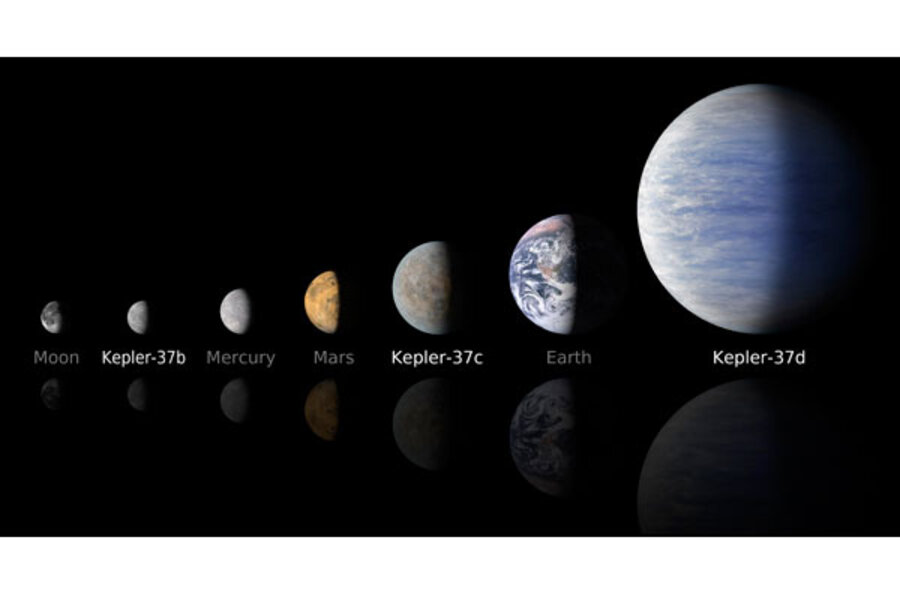Discovery of smallest planet yet a 'milestone' in search for another Earth
For nearly 20 years, astronomers have filled the pantheon of planets beyond the solar system with objects ranging from behemoths several times Jupiter's mass to small orbs somewhat less hefty than Earth.
Now, a team reports finding the smallest planet yet – a true pipsqueak orbiting a sun-like star some 215 light-years away near the constellation Cygnus. The planet has a mass at least 1 percent of Earth's mass, probably more. And it's about 30 percent Earth's size. This is slightly larger than the moon, which is 27 percent the size of Earth.
The planet, one of three in the system, orbits its host star once every 13.4 days.
Finding the smallest planet yet is more than an "isn't it cute" moment, suggests Thomas Barclay, an astronomer at NASA's Ames Research Center at Moffett Field, Calif.
"This is a milestone" on the path to finding Earth-like planets, says Dr. Barclay, who is the lead author of a report of the find, which appears in Thursday's issue of the journal Nature.
The observations come courtesy of NASA's Kepler mission, a sensitive space telescope that observes more than 150,000 stars simultaneously in and near the head of Cygnus around the clock. Kepler's ultimate goal is to find Earth-like planets orbiting sun-like stars at Earth-like distances.
Kepler 37b, as the planet is known, is more like a mini-Mercury but on a much tighter orbit. But "the sort of precision we need from the instrument" to achieve the mission's goal "is demonstrated through this discovery."
In essence, the planet's very weak signature at some 9.3 million miles from its star is comparable to the signature researchers expect to see from an Earth-mass planet 93 million miles from its star, Earth's average distance from the sun. A planet betrays itself to Kepler by dimming its star's light repeatedly as it passes in front of it, a process astronomers call the transit method for detecting extrasolar planets.
The detection of Kepler 37b was extremely difficult, Barclay says. Many transits were needed to build up enough data to spot the dimming the planet imparts to the star. And Kepler's ability to take very precise measurements of the star's own light helped the team develop a highly accurate estimate of the star's size and mass.
Just as geophysicists can use earthquake vibrations traveling through the Earth to reconstruct the planet's interior, astrophysicists can use the same approach for determining the structure of distant stars. Kepler takes the measure of a star by recording rapid changes in its brightness from what in essence are sound waves moving through the hot gas.
In some cases, Kepler's insight into a star has forced team members to boost the size and mass estimates of its planets. These revisions mean planets that were initially thought to be comparable in size and mass to Earth, often turn out not to be rocky planets in all likelihood, Barclay explains.
So when Barclay took his data suggesting a tiny planet to the Kepler mission's resident astroseismologist, the colleague was not optimistic. "But then he came running down the corridor saying: 'I've detected something!' " Barclay recalls. Extremely precise measurements of the star Kepler 37 indicated that it indeed was relatively small star, hence the initial estimate of Kepler 37b as a munchkin held up.
Unfortunately, independent efforts to confirm the planet's presence with Earth-based telescopes using a different detection approach – which spots the wobble a star's spectrum displays from the gravitational tug of an orbiting planet – came up empty.
Still, the Kepler team was able to rule out other possible explanations for Kepler 37's dimming to a high degree of confidence using statistical tools and the long observations of the star and its cosmic neighborhood.
Computer simulations suggest that the planet and its two siblings are in a stable configuration around the star, and that the planet likely is rocky and devoid of an atmosphere. The simulations also indicated that Kepler 37b would have swept its orbital zone clear of any debris left over from the system's formation some 6 billion years ago. This puts it squarely in the "planet" camp, despite its diminutive size, versus "dwarf planet," the category to which Pluto has been exiled.
"This is a hot planet on a short orbit," Barclay says. "The next step is to look for planets on longer orbital periods. It's just a matter of time. The longer you look, the further out in orbital period you can probe."
But he's not undervaluing this discovery.
"The fact that we are finding things smaller than we know of in our own solar system I think is really exciting," he says. "We're probing the architectures of other star systems."





